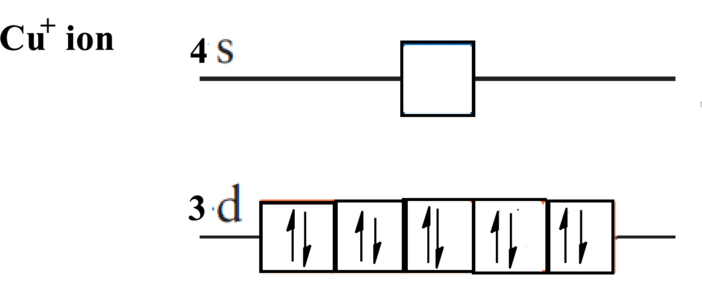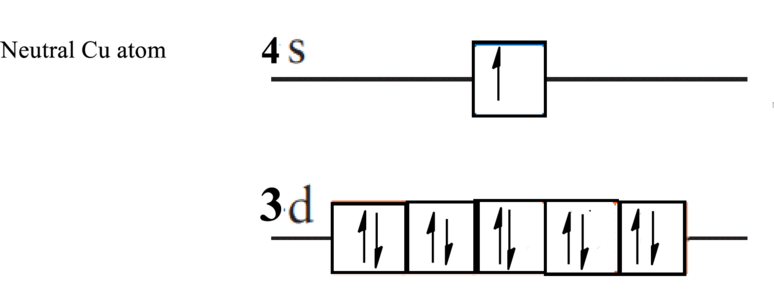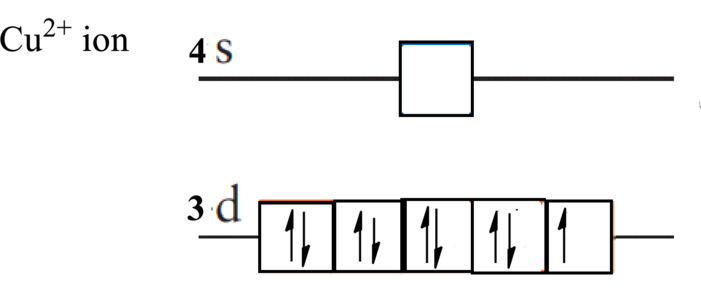
(a)
Interpretation:
The electronic configuration of
Concept Introduction:
The fundamental principles that are followed to write an electronic configuration include three rules as follows:
Electron in a

Hund’s rule suggests electrons are not allowed to be paired up until each degenerate set of orbital has got at least one electron.
Pauli Exclusion Principle states two electrons within the same orbital cannot possess same set for four possible quantum numbers.
(a)
Answer to Problem 2A.1AST
The electronic configuration of
Explanation of Solution
Copper is a d-block metal that loses it valence electrons to form

After a loss of one electron from the valence

(b)
Interpretation:
The electronic configuration of
Concept Introduction:
Refer to part (a).
(b)
Answer to Problem 2A.1AST
The electronic configuration of
Explanation of Solution
Copper is a d-block metal that loses its valence electrons to form

After loss of two electron from the valence

Want to see more full solutions like this?
Chapter 2 Solutions
CHEMICAL PRIN. (LL)+ 2 SEM SAPLING >BI<
- What is the electron configuration of the Ba3+ ion? Suggest a reason why this ion is not normally found in nature.arrow_forwardWithout consulting any tables, arrange the following substances in order and explain your choice of order: (a) Mg2+,Ar,Br,Ca2+ in order of increasing radius (b) Na, Na+ , O, Ne in order of increasing ionization energy (c) H, F, Al, O in order of increasing electronegativityarrow_forwardWrite the electron configuration for each of the following ions: (a) As3 (b) I (c) Be2+ (d) Cd2+ (e) O2 (f) Ga3+ (g) Li+ (h) N3 (j) Sn2+ (j) Co2+ (k) Fe2+ (1) As3+arrow_forward
- An ion M2+ has the configuration [Ar]3d2, and an atom has the configuration [Ar]4s2. Identify the ion and the atom.arrow_forward• use electron configurations to explain why metals tend to form cations whereas nonmetals tend to form anions.arrow_forwardWhat is the significance of knowing the properties of elements (periodic table) in the food industry and medicine?arrow_forward
- What is the periodic trend in ionic size for the cations of these alkaline earth elements: Mg2+, Ca2+, Sr2+, Ba2+?arrow_forwardWrite ground-state electron configurations for the following ions: K+, Mg2+, O2-, I-, Al3+,arrow_forwardDiscuss the importance of electron affinity and ionizationenergy in the formation of ions.arrow_forward
 Chemistry by OpenStax (2015-05-04)ChemistryISBN:9781938168390Author:Klaus Theopold, Richard H Langley, Paul Flowers, William R. Robinson, Mark BlaserPublisher:OpenStax
Chemistry by OpenStax (2015-05-04)ChemistryISBN:9781938168390Author:Klaus Theopold, Richard H Langley, Paul Flowers, William R. Robinson, Mark BlaserPublisher:OpenStax Chemistry for Engineering StudentsChemistryISBN:9781337398909Author:Lawrence S. Brown, Tom HolmePublisher:Cengage Learning
Chemistry for Engineering StudentsChemistryISBN:9781337398909Author:Lawrence S. Brown, Tom HolmePublisher:Cengage Learning Chemistry: Principles and PracticeChemistryISBN:9780534420123Author:Daniel L. Reger, Scott R. Goode, David W. Ball, Edward MercerPublisher:Cengage Learning
Chemistry: Principles and PracticeChemistryISBN:9780534420123Author:Daniel L. Reger, Scott R. Goode, David W. Ball, Edward MercerPublisher:Cengage Learning Chemistry & Chemical ReactivityChemistryISBN:9781337399074Author:John C. Kotz, Paul M. Treichel, John Townsend, David TreichelPublisher:Cengage Learning
Chemistry & Chemical ReactivityChemistryISBN:9781337399074Author:John C. Kotz, Paul M. Treichel, John Townsend, David TreichelPublisher:Cengage Learning General Chemistry - Standalone book (MindTap Cour...ChemistryISBN:9781305580343Author:Steven D. Gammon, Ebbing, Darrell Ebbing, Steven D., Darrell; Gammon, Darrell Ebbing; Steven D. Gammon, Darrell D.; Gammon, Ebbing; Steven D. Gammon; DarrellPublisher:Cengage Learning
General Chemistry - Standalone book (MindTap Cour...ChemistryISBN:9781305580343Author:Steven D. Gammon, Ebbing, Darrell Ebbing, Steven D., Darrell; Gammon, Darrell Ebbing; Steven D. Gammon, Darrell D.; Gammon, Ebbing; Steven D. Gammon; DarrellPublisher:Cengage Learning Chemistry: The Molecular ScienceChemistryISBN:9781285199047Author:John W. Moore, Conrad L. StanitskiPublisher:Cengage Learning
Chemistry: The Molecular ScienceChemistryISBN:9781285199047Author:John W. Moore, Conrad L. StanitskiPublisher:Cengage Learning





